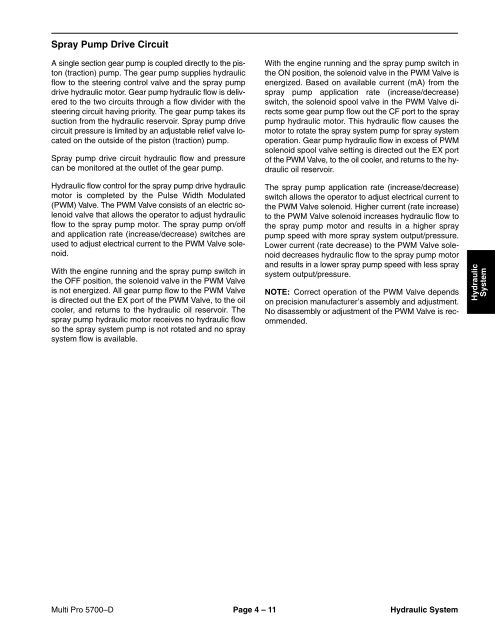Multi Pro 5700 - Toro
Multi Pro 5700 - Toro
Multi Pro 5700 - Toro
You also want an ePaper? Increase the reach of your titles
YUMPU automatically turns print PDFs into web optimized ePapers that Google loves.
Spray Pump Drive Circuit<br />
A single section gear pump is coupled directly to the piston<br />
(traction) pump. The gear pump supplies hydraulic<br />
flow to the steering control valve and the spray pump<br />
drive hydraulic motor. Gear pump hydraulic flow is delivered<br />
to the two circuits through a flow divider with the<br />
steering circuit having priority. The gear pump takes its<br />
suction from the hydraulic reservoir. Spray pump drive<br />
circuit pressure is limited by an adjustable relief valve located<br />
on the outside of the piston (traction) pump.<br />
Spray pump drive circuit hydraulic flow and pressure<br />
can be monitored at the outlet of the gear pump.<br />
Hydraulic flow control for the spray pump drive hydraulic<br />
motor is completed by the Pulse Width Modulated<br />
(PWM) Valve. The PWM Valve consists of an electric solenoid<br />
valve that allows the operator to adjust hydraulic<br />
flow to the spray pump motor. The spray pump on/off<br />
and application rate (increase/decrease) switches are<br />
used to adjust electrical current to the PWM Valve solenoid.<br />
With the engine running and the spray pump switch in<br />
the OFF position, the solenoid valve in the PWM Valve<br />
is not energized. All gear pump flow to the PWM Valve<br />
is directed out the EX port of the PWM Valve, to the oil<br />
cooler, and returns to the hydraulic oil reservoir. The<br />
spray pump hydraulic motor receives no hydraulic flow<br />
so the spray system pump is not rotated and no spray<br />
system flow is available.<br />
With the engine running and the spray pump switch in<br />
the ON position, the solenoid valve in the PWM Valve is<br />
energized. Based on available current (mA) from the<br />
spray pump application rate (increase/decrease)<br />
switch, the solenoid spool valve in the PWM Valve directs<br />
some gear pump flow out the CF port to the spray<br />
pump hydraulic motor. This hydraulic flow causes the<br />
motor to rotate the spray system pump for spray system<br />
operation. Gear pump hydraulic flow in excess of PWM<br />
solenoid spool valve setting is directed out the EX port<br />
of the PWM Valve, to the oil cooler, and returns to the hydraulic<br />
oil reservoir.<br />
The spray pump application rate (increase/decrease)<br />
switch allows the operator to adjust electrical current to<br />
the PWM Valve solenoid. Higher current (rate increase)<br />
to the PWM Valve solenoid increases hydraulic flow to<br />
the spray pump motor and results in a higher spray<br />
pump speed with more spray system output/pressure.<br />
Lower current (rate decrease) to the PWM Valve solenoid<br />
decreases hydraulic flow to the spray pump motor<br />
and results in a lower spray pump speed with less spray<br />
system output/pressure.<br />
NOTE: Correct operation of the PWM Valve depends<br />
on precision manufacturer’s assembly and adjustment.<br />
No disassembly or adjustment of the PWM Valve is recommended.<br />
Hydraulic<br />
System<br />
<strong>Multi</strong> <strong>Pro</strong> <strong>5700</strong>–D Page 4 – 11 Hydraulic System
















